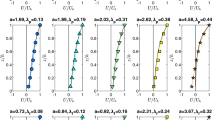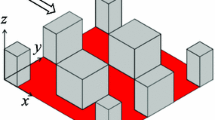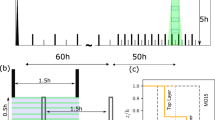Abstract
We used wind-tunnel experiments to investigate velocity-field adjustment and scalar diffusion behaviour in and above urban canopies located downwind of various roughness elements. Staggered arrays of rectangular blocks of various heights H and plan area ratios λp were used to model the urban canopies. The velocity field in the roughness sublayer (height \({z \lesssim 2H}\)) reached equilibrium at distances proportional to \({\sqrt{L_{\rm c}H}}\) where L c is the canopy-drag length scale determined as a function of λp and the block side length L. A distance of about \({20\sqrt{L_{\rm c}H}}\) was required for adjustment at z = H/2 (in the canopy), and a distance of about \({10\sqrt{L_{\rm c}H}}\) was required at z = 2H (near the top of the roughness sublayer). Diffusion experiments from a ground emission source revealed that differences in upwind roughness conditions had negligible effects on the plume growth near the source (up to a few multiples of L from the source) if the source was located at a fetch F larger than about \({10\sqrt{L_{\rm c}H}}\) from the upwind edge of the canopy. However, at locations farther downwind (more than several multiples of L from the source), upwind conditions had considerable effects on the plume growth. For a representative urban canopy, it was shown that a much larger fetch than required for velocity-field adjustment in the roughness sublayer was necessary to eliminate the effects of upwind conditions on plume widths at 24L downwind from the source.
Similar content being viewed by others
References
Belcher SE, Jerram N, Hunt JCR (2003) Adjustment of a turbulent boundary layer to a canopy of roughness elements. J Fluid Mech 488: 369–398
Britter RE, Hanna SR, Briggs GA, Robins A (2003) Short-range vertical dispersion from a ground level source in a turbulent boundary layer. Atmos Environ 37: 3885–3894
Britz D, Antonia RA (1996) A comparison of methods of computing power spectra of LDA signals. Meas Sci Technol 7: 1042–1053
Brown MJ, Arya SP, Snyder WH (1993) Vertical dispersion from surface and elevated releases: an investigation of a non-Gaussian plume model. J Appl Meteorol 32: 490–505
Castro IP (1984) Effects of free stream turbulence on low Reynolds number boundary layers. J Fluids Eng 106: 298–306
Cheng H, Castro IP (2002) Near wall flow over urban-like roughness. Boundary-Layer Meteorol 104: 229–259
Coceal O, Belcher SE (2004) A canopy model of mean winds through urban areas. Q J Roy Meteorol Soc 130: 1349–1372
Corrsin S (1963) Estimates of the relations between Eulerian and Lagrangian scales in large Reynolds number turbulence. J Atmos Sci 20: 115–119
Counihan J (1969) An improved method of simulating an atmospheric boundary layer in a wind tunnel. Atmos Environ 3: 197–214
Csanady GT (1973) Turbulent diffusion in the environment. D. Reidel Publishing Co., Dordrecht, p 248
Davidson MJ, Snyder WH, Lawson REJ, Hunt JCR (1996) Wind tunnel simulations of plume dispersion through groups of obstacles. Atmos Environ 30: 3715–3731
DeGraaff DB, Eaton JK (2000) Reynolds-number scaling of the flat-plate turbulent boundary layer. J Fluid Mech 422: 319–346
Degrazia G, Anfossi D (1998) Estimation of the Kolmogorov constant C 0 from classical statistical diffusion theory. Atmos Environ 32: 3611–3614
Du S, Venkatram A (1997) A parameterization of vertical dispersion of ground-level releases. J Appl Meteorol 36: 1004–1015
Gailis RM, Hill A (2006) A wind-tunnel simulation of plume dispersion within a large array of obstacles. Boundary-Layer Meteorol 119: 289–338
Galassi M, Davies J, Theiler J, Gough B, Jungman G, Booth M, Rossi F (2003) GNU scientific library: reference manual, 2nd edn. Network Theory Ltd, Bristol
Grimmond CSB, Oke TR (1999) Aerodynamic properties of urban areas derived from analysis of surface form. J Appl Meteorol 38: 1262–1292
Hagishima A, Tanimoto J, Nagayama K, Meno S (2009) Aerodynamic parameters of regular arrays of rectangular blocks with various geometries. Boundary-Layer Meteorol 132: 315–337
Hunt JCR, Weber AH (1979) A Lagrangian statistical analysis of diffusion from a ground-level source in a turbulent boundary layer. Q J Roy Meteorol Soc 105: 423–443
Leonardi S, Castro IP (2010) Channel flow over large cube roughness: a direct numerical simulation study. J Fluid Mech 651: 519–539
Macdonald RW (2000) Modelling the mean velocity profile in the urban canopy layer. Boundary-Layer Meteorol 97: 25–45
Macdonald RW, Griffiths RF, Hall DJ (1998a) A comparison of results from scaled field and wind tunnel modelling of dispersion in arrays of obstacles. Atmos Environ 32: 3845–3862
Macdonald RW, Griffiths RF, Hall DJ (1998b) An improved method for the estimation of surface roughness of obstacle arrays. Atmos Environ 32: 1857–1864
Mfula AM, Kukadia V, Griffiths RF, Hall DJ (2005) Wind tunnel modelling of urban building exposure to outdoor pollution. Atmos Environ 39: 2737–2745
Ogawa Y, Diosey PG, Uehara K, Ueda H (1981) A wind tunnel for studying the effects of thermal stratification in the atmosphere. Atmos Environ 15: 807–821
Patel VC (1965) Calibration of the Preston tube and limitations on its use in pressure gradients. J Fluid Mech 23: 185–205
Pope SB (2000) Turbulent flows. Cambridge University Press, Cambridge, p 770
Raupach MR, Hughes HA, Cleugh DE (2006) Momentum absorption in rough-wall boundary layers with sparse roughness elements in a random and clustered distributions. Boundary-Layer Meteorol 120: 201–218
Robins AG (1979) The development and structure of simulated neutrally stable atmospheric boundary layers. J Ind Aerodyn 4: 71–100
Robins A (2003) Wind tunnel dispersion modelling some recent and not so recent achievements. J Wind Eng Ind Aerodyn 91: 1777–1790
Salizzoni P, van Liefferinge R, Soulhac L, Mejean P, Perkins RJ (2009) Influence of wall roughness on the dispersion of a passive scalar in a turbulent boundary layer. Atmos Environ 43: 734–748
Snyder WH, Lawson REJ (1993) Wind-tunnel simulation of building downwash from electric-power generating stations. Part II: Pulsed-wire measurements in the vicinity of steam-boiler building. Fluid Modeling Facility Internal Report, US-EPA
Spalart PR (1988) Direct simulation of a turbulent boundary layer up to R θ = 1410. J Fluid Mech 187: 61–98
Author information
Authors and Affiliations
Corresponding author
Rights and permissions
About this article
Cite this article
Kanda, I., Yamao, Y. Velocity Adjustment and Passive Scalar Diffusion in and Above an Urban Canopy in Response to Various Approach Flows. Boundary-Layer Meteorol 141, 415–441 (2011). https://doi.org/10.1007/s10546-011-9646-9
Received:
Accepted:
Published:
Issue Date:
DOI: https://doi.org/10.1007/s10546-011-9646-9




